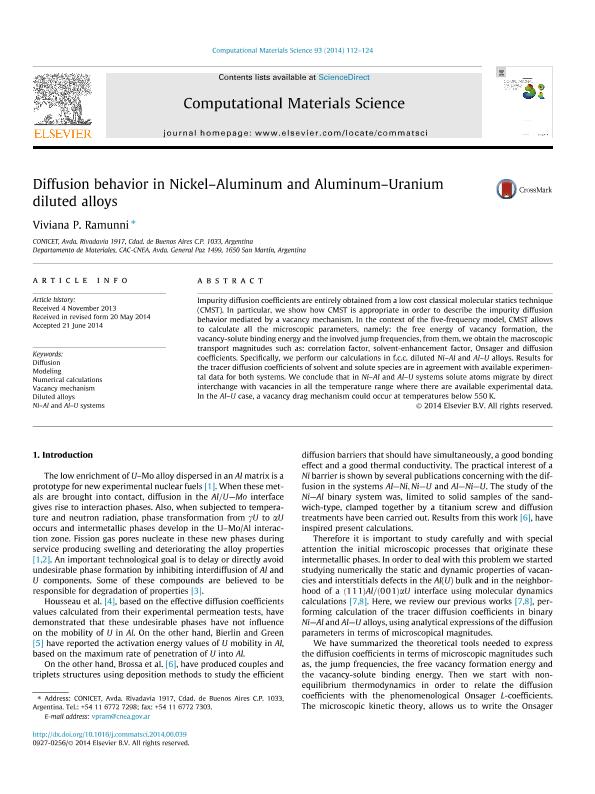Mostrar el registro sencillo del ítem
dc.contributor.author
Ramunni, Viviana Patricia

dc.date.available
2018-02-05T21:14:52Z
dc.date.issued
2014-07
dc.identifier.citation
Ramunni, Viviana Patricia; Diffusion behavior in Nickel–Aluminum and Aluminum-Uranium diluted alloys; Elsevier Science; Computational Materials Science; 93; 7-2014; 112-124
dc.identifier.issn
0927-0256
dc.identifier.uri
http://hdl.handle.net/11336/35698
dc.description.abstract
Impurity diffusion coefficients are entirely obtained from a low cost classical molecular statics technique (CMST). In particular, we show how CMST is appropriate in order to describe the impurity diffusion behavior mediated by a vacancy mechanism. In the context of the five-frequency model, CMST allows to calculate all the microscopic parameters, namely: the free energy of vacancy formation, the vacancy-solute binding energy and the involved jump frequencies, from them, we obtain the macroscopic transport magnitudes such as: correlation factor, solvent-enhancement factor, Onsager and diffusion coefficients. Specifically, we perform our calculations in f.c.c. diluted Ni–Al and Al–U alloys. Results for the tracer diffusion coefficients of solvent and solute species are in agreement with available experimental data for both systems. We conclude that in Ni–Al and Al–U systems solute atoms migrate by direct interchange with vacancies in all the temperature range where there are available experimental data. In the Al–U case, a vacancy drag mechanism could occur at temperatures below 550 K.
dc.format
application/pdf
dc.language.iso
eng
dc.publisher
Elsevier Science

dc.rights
info:eu-repo/semantics/openAccess
dc.rights.uri
https://creativecommons.org/licenses/by-nc-nd/2.5/ar/
dc.subject
Diffusion
dc.subject
Moddeling
dc.subject
Numerical Calculations
dc.subject
Vacancy Mechanism
dc.subject
Diluted Alloys
dc.subject
Nial And Alu
dc.subject.classification
Otras Ingeniería de los Materiales

dc.subject.classification
Ingeniería de los Materiales

dc.subject.classification
INGENIERÍAS Y TECNOLOGÍAS

dc.title
Diffusion behavior in Nickel–Aluminum and Aluminum-Uranium diluted alloys
dc.type
info:eu-repo/semantics/article
dc.type
info:ar-repo/semantics/artículo
dc.type
info:eu-repo/semantics/publishedVersion
dc.date.updated
2018-02-05T20:16:02Z
dc.journal.volume
93
dc.journal.pagination
112-124
dc.journal.pais
Países Bajos

dc.journal.ciudad
Amsterdam
dc.description.fil
Fil: Ramunni, Viviana Patricia. Consejo Nacional de Investigaciones Científicas y Técnicas; Argentina. Comisión Nacional de Energía Atómica. Centro Atómico Constituyentes; Argentina
dc.journal.title
Computational Materials Science

dc.relation.alternativeid
info:eu-repo/semantics/altIdentifier/doi/http://dx.doi.org/10.1016/j.commatsci.2014.06.039
dc.relation.alternativeid
info:eu-repo/semantics/altIdentifier/url/https://www.sciencedirect.com/science/article/pii/S0927025614004509
Archivos asociados
